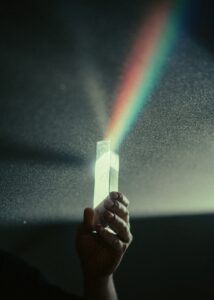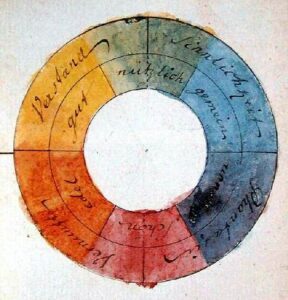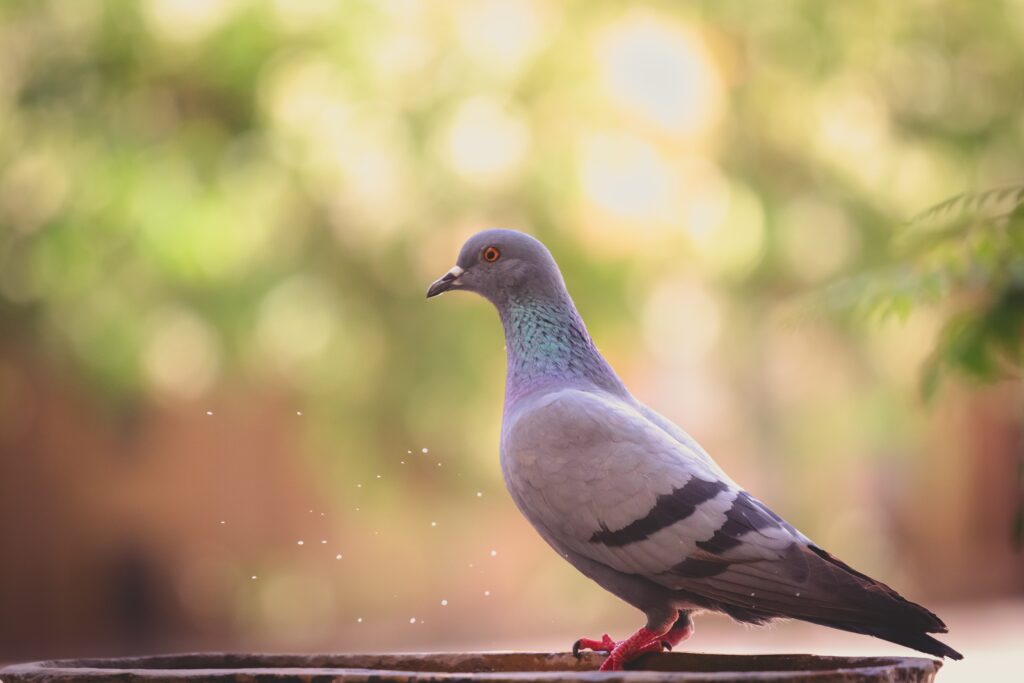Colours.
We see it all around us. Red, blue, green, and purple. But where do colours come from? And is it a form of light that Newton suggested?
Let’s start off with Newton, as many took his basic premise that colour arrives from white light. How did he start playing with colour and light? He made a pinhole in his curtain window, allowed the light to shine through, and placed a prism to capture and refract the light at the perfect angle.
What happened next?
The iconic image of the Prism.
Hence his conclusion, without light, there is no colour. Colour is refracted from light.

Now, Johann Wolfgang von Goethe played with this concept a little further. He discovered new colours, that were left out of Newton’s equation.
Goethe, a German born poet, playwright, novelist, scientist, statesman, and well…a very multi-faceted, multi-dimensional man, expanded on Newton’s theory of colour.
Goethe believed it wasn’t light alone that created colour, but darkness as well.
And our eyes, naturally look for harmonic colours and create a complimentary colour in the shadows. No joke.
Was totally amazed by this and wondered why we weren’t taught this in our academic school system. Allow me to demonstrate.
Experiment One: Light and Shadow – Hidden Complimentary Colours.
A) Take a dark room. Place a cone in the middle.
B) Fill the room with two projectors of light, one on each end of the cone.
C) Take one end, turn the light on, and place a coloured filter on it. Let’s say green. And let the other light be.
D) This will create a natural green light to be illuminated on the center cone display, where the green filter is… minus the dark, grey shadow.
Since the other light projector is not turned on, it will leave a shadow.
Now, turn the other light on WITHOUT the filter. Just plain light.
And what do you see?
The grey shadow area lights up in MAGENTA! The complimentary colour to green!
And this happens to the other colours as well, as we create the complimentary colour. Purple to Blue. Cyan Blue to Red.
And this is what our eyes want to see, according to Goethe – Harmony, through complimentary colours.
And so, we create magenta to see in compliment to green, in the ‘shadow,’ of the object.
And if you were to zoom into the magenta, like really zoom in.
Do you know what you see? Grey again.
Wow, this truly is the amazing and magical world of colours!

“Color itself is a degree of darkness. Color is an essential part of how we experience the world, both biologically and culturally.” – Johann Wolfgang von Goethe
What I appreciate about Goethe approach versus Newton’s, is that he has a more holistic approach not only to colours, but to life. His colour wheel, included all spectrums of light, that was both observed in the darkness and light. He believed, the two were inseparable.
And such is the polarity of life, the light and the dark, the yin and yang. The duality and polarity of life.
Experiment Two: The Importance of Yellow and Blue – The Basis of All Colours
Goethe believed the atmosphere, consisted of particles and dust. He conducted an experiment of the, ‘Turbid-sphere,’ as he called it.
So, he created a box with a transparent glass lid.
A) When he lifted the lid of the box, with the transparent glass on it, facing the light. It turned – Yellow.
B) When you closed the box and the transparent lid faced the dark, the interior. The transparent glass turned – Blue.
Blue and Yellow make Green.
And as you intensify these two colours via it’s density, or intensity.
It creates the whole colour spectrum. Therefore, Blue and Yellow, were the basis of the colour wheel and are found near the bottom of the colour chart (see: Antique Colour Wheel.)
Experiment Three: Colour Intensification.
If you were to a glass stairway, hollow and empty. Fill it with water. Then add a drop of yellow dye to one stairway.
And the other separate staircase, blue. This is what you would get:
Staircase with Yellow Dye:
- Canary yellow (The larger, bottom step.)
- To light orange (Middle step.)
- Then Red. (Shortest step. The Denser the yellow becomes, the more Red it gets.)
Staircase with Blue Dye:
- Cyan Blue
- Blue
- Dark Blue
- Violet (More Dense.)
This also leads to me conclude and apply this to the world of Dimensions and Densities.
Many people who have experienced NDE’s (Near Death Experiences) and/or Astral Traveled – describe how vibrant the colours are in these realms of existence. They are more vivid and bright, they say. That’s the real world, the poet’s say, and we dream this reality.
Perhaps, this has lead to me conclude, that this reality is at the bottom of the staircase.
As we rise to lighter densities, we reach a spectrum of vibrant, bright colours, that exists only in those realms or planes of existence. Up the staircase so to speak, like a Stairway to Heaven.
So, perhaps, when those individuals experience NDE’s. They ‘leave their denser, more heavy bodies behind,’ and ‘elevate’ to Higher Realms of Consciousness, where different colours exist!
I do want to say, Pigeons, don’t have to have NDE’s in order to experience a whole, new array of colours. They see ULTRAVIOLET colours. Whereas humans, see the Rainbow – ROYGBIV.

Octopi, by the way, can camouflage their colours to their natural habitat and even duplicate the patterns to a tee! And they are believed to be…Colour Blind? How is that possible? Do they experience colour differently than we do?
Colours are a whole other ball game as you can tell, we are starting to embark on, the wonderful and magical world of colours.
Hope you In-Joyed this,
Much Love,
Pamela
References:
Royalty Free Images:
Prism by Braxton Apana – Unsplash
Penguin by Lenstravelier – Unsplash
Great video demonstration of Goethe’s Theory on Colours found here.
Pigeons: https://treehozz.com/what-colour-do-pigeons-see
Octopus: The Soul of An Octopus Interview with Author – Sy Montgomery
Dinshaw Colour Therapy: http://www.dinshahcolortherapy.com/

